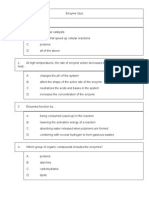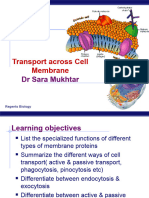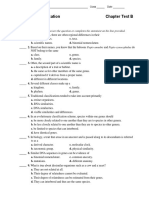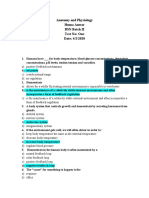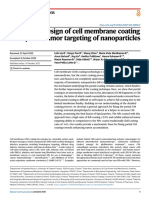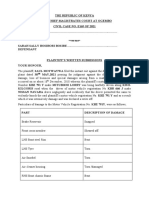0 ratings0% found this document useful (0 votes)
554 viewsA.2.3. Passive Transport Systems MCQs
A.2.3. Passive Transport Systems MCQs
Uploaded by
Palanisamy SelvamaniThe document contains a multiple choice quiz about passive transport systems. It includes 8 questions about processes like diffusion, facilitated diffusion, osmosis, and filtration. The questions cover topics such as what requires energy, differences between the transport processes, definitions of terms like semi-permeable membranes and hypotonic solutions.
Copyright:
© All Rights Reserved
Available Formats
Download as PDF, TXT or read online from Scribd
A.2.3. Passive Transport Systems MCQs
A.2.3. Passive Transport Systems MCQs
Uploaded by
Palanisamy Selvamani0 ratings0% found this document useful (0 votes)
554 views3 pagesThe document contains a multiple choice quiz about passive transport systems. It includes 8 questions about processes like diffusion, facilitated diffusion, osmosis, and filtration. The questions cover topics such as what requires energy, differences between the transport processes, definitions of terms like semi-permeable membranes and hypotonic solutions.
Copyright
© © All Rights Reserved
Available Formats
PDF, TXT or read online from Scribd
Share this document
Did you find this document useful?
Is this content inappropriate?
The document contains a multiple choice quiz about passive transport systems. It includes 8 questions about processes like diffusion, facilitated diffusion, osmosis, and filtration. The questions cover topics such as what requires energy, differences between the transport processes, definitions of terms like semi-permeable membranes and hypotonic solutions.
Copyright:
© All Rights Reserved
Available Formats
Download as PDF, TXT or read online from Scribd
Download as pdf or txt
0 ratings0% found this document useful (0 votes)
554 views3 pagesA.2.3. Passive Transport Systems MCQs
A.2.3. Passive Transport Systems MCQs
Uploaded by
Palanisamy SelvamaniThe document contains a multiple choice quiz about passive transport systems. It includes 8 questions about processes like diffusion, facilitated diffusion, osmosis, and filtration. The questions cover topics such as what requires energy, differences between the transport processes, definitions of terms like semi-permeable membranes and hypotonic solutions.
Copyright:
© All Rights Reserved
Available Formats
Download as PDF, TXT or read online from Scribd
Download as pdf or txt
You are on page 1of 3
BasicPhysiology.
com
MULTIPLE CHOICE QUESTIONS
A.2.3. Passive Transport Systems
1. Which of the following transport systems require energy?
a) Diffusion
b) Facilitated diffusion
c) Exocytosis
d) Osmosis
e) Filtration
2. The rate at which diffusion takes place is determined by the following
conditions EXCEPT:
a) the temperature
b) the concentration difference
c) the distance for diffusion
d) the size of the area of diffusion
e) the direction of the diffusion
3. At what temperature is diffusion (=Brownian motion) fully stopped?
a) 0oC
b) 0oF
c) -100oK
d) -100oF
e) 0oK
4. What is the major difference between diffusion and facilitated diffusion?
a) Requires energy
b) Does not require energy
c) Only operates into a cell
d) Operates across a cell membrane
e) Requires a specific carrier
5. What is the major difference between diffusion and osmosis?
a) Osmosis requires energy
b) Osmosis does not require energy
c) Diffusion does not require energy
d) Osmosis transports water while diffusion transports solute
e) Osmosis transports solute while diffusion transports water
6. What is the major difference between filtration and osmosis?
a) Filtration requires energy
b) Osmosis requires energy
c) Osmosis transports water while filtration does not
d) Filtration transports water due to a pressure difference
e) Osmosis transports water due to a pressure difference
© BasicPhysiology.com MCQ’s Passive Transport Systems page 1/3
BasicPhysiology.com
7. What is a semi-permeable membrane?
a) A membrane that is permeable for a solute but not for water
b) A membrane that is permeable for water but not for a solute
c) A membrane that is permeable depending on an external stimuli
d) A membrane that is permeable in one direction but not in the other
direction
e) A membrane that is permeable for a particular solute
8. What is a hypotonic solution?
a) An external solution with a higher concentration than inside a cell
b) An external solution with a lower concentration than inside a cell
c) An external solution with the same concentration as inside the cell
d) An external solution of 0.9% NaCl.
e) An internal solution with 0.9% NaCl.
© BasicPhysiology.com MCQ’s Passive Transport Systems page 2/3
BasicPhysiology.com
Answers:
1. c.
2. e.
3. e.
4. e.
5. d.
6. d.
7. b.
8. b.
© BasicPhysiology.com MCQ’s Passive Transport Systems page 3/3
You might also like
- Cell Structure, Function Practice Test With AnswersDocument16 pagesCell Structure, Function Practice Test With AnswersDJ ISAACSNo ratings yet
- Biology I-Mitosis Test BankDocument9 pagesBiology I-Mitosis Test BankAmos Josephat100% (2)
- Long Test No. 4 (Nervous System) Ready To PrintDocument3 pagesLong Test No. 4 (Nervous System) Ready To Printjayrald cruzada100% (1)
- Quiz TEMDocument2 pagesQuiz TEMshoeb3210% (2)
- Quiz 5 Scin130Document11 pagesQuiz 5 Scin130new rhondaldNo ratings yet
- Chapter 5 Membrane Structure and Function: Multiple Choice QuestionsDocument11 pagesChapter 5 Membrane Structure and Function: Multiple Choice QuestionsJohn MixerNo ratings yet
- Cell TheoryDocument26 pagesCell Theoryحفيظو عبداللهNo ratings yet
- C8e 49 Test BankDocument12 pagesC8e 49 Test BankSali Iqra0% (1)
- CH 5 Membrane Dynamics Test PDFDocument42 pagesCH 5 Membrane Dynamics Test PDFمؤيد العلاميNo ratings yet
- Industrial Biochemistry - 609u1Document27 pagesIndustrial Biochemistry - 609u1Palanisamy Selvamani100% (1)
- Installation Poster EVC-C2 Calibration IPS Quad InstallationDocument2 pagesInstallation Poster EVC-C2 Calibration IPS Quad Installation????No ratings yet
- A.2.4. Active Transport Systems MCQsDocument2 pagesA.2.4. Active Transport Systems MCQsPalanisamy SelvamaniNo ratings yet
- Quiz Cell MembraneDocument4 pagesQuiz Cell MembraneDeepan Chakkaravarthi100% (1)
- 07 Test BankDocument18 pages07 Test BankAditya PaluriNo ratings yet
- G8 - 50 MCQsDocument10 pagesG8 - 50 MCQs胡哲菁No ratings yet
- Reduced Answer Cell Transport Level Test 2016Document3 pagesReduced Answer Cell Transport Level Test 2016John Kevin NocheNo ratings yet
- Question and Answers Membrane Transport Extended Response QuestionDocument4 pagesQuestion and Answers Membrane Transport Extended Response QuestionJohn OsborneNo ratings yet
- AnswerKey BIO311c Worksheet3 2006 CellsDocument2 pagesAnswerKey BIO311c Worksheet3 2006 Cellsjessie4466No ratings yet
- 3RD Q Module 1 Quiz 2 Endocrine SystemDocument2 pages3RD Q Module 1 Quiz 2 Endocrine Systemsinunuc nhsNo ratings yet
- Enzyme QuizDocument9 pagesEnzyme Quizerin_slatenNo ratings yet
- Self-Assessment Questions Chapter 6 The Respiratory SystemDocument7 pagesSelf-Assessment Questions Chapter 6 The Respiratory Systemروان امير غني عبد عونNo ratings yet
- 11.0 Homeostasis - Longman MCQ QuestionsDocument12 pages11.0 Homeostasis - Longman MCQ QuestionsverysedatedxNo ratings yet
- Nervous SystemDocument2 pagesNervous System234iagiaNo ratings yet
- MCQ PharmacokineticsDocument10 pagesMCQ PharmacokineticsHarshit Sharma100% (1)
- Worksheet 2 Homeostasis Answer KeyDocument3 pagesWorksheet 2 Homeostasis Answer KeyMohammed AmerNo ratings yet
- Photosynthesis Respiration ExamDocument11 pagesPhotosynthesis Respiration ExamAmor Panopio Magtibay100% (1)
- Possible Essay Questions Exam #2Document1 pagePossible Essay Questions Exam #246bwilsonNo ratings yet
- Transport Across Cell MembraneDocument38 pagesTransport Across Cell Membranemishal.sarosh75100% (1)
- d0846503 Bio ch18 B 2 Files MergedDocument9 pagesd0846503 Bio ch18 B 2 Files Mergedapi-364565466100% (1)
- Ezyme 2Document3 pagesEzyme 2Nini Besi100% (1)
- Cell CycleDocument2 pagesCell Cyclelhemi100% (1)
- Chromosomal Aberrations: Deficiency or DeletionDocument4 pagesChromosomal Aberrations: Deficiency or Deletionvandv printsNo ratings yet
- Homeostasis Feedback MechanismsDocument21 pagesHomeostasis Feedback MechanismsAsd DadaNo ratings yet
- Test - Embryology Practice Questions With Answers - QuizletDocument13 pagesTest - Embryology Practice Questions With Answers - QuizletAzizNo ratings yet
- Digestion Test BiologyDocument3 pagesDigestion Test BiologyKatrīna SimanovskaNo ratings yet
- Integumentary Practice Test PDFDocument3 pagesIntegumentary Practice Test PDFRaed Al-HweiyyanNo ratings yet
- MCQ Hap-II, Bp201tDocument39 pagesMCQ Hap-II, Bp201tANUJ DEVNo ratings yet
- Proteins AnswersDocument2 pagesProteins AnswersBiancake Sta. AnaNo ratings yet
- I. /58 II. /28 Total: Strictly No Erasures and Alterations Only in Multiple-Choice PartDocument2 pagesI. /58 II. /28 Total: Strictly No Erasures and Alterations Only in Multiple-Choice PartBren DonatosNo ratings yet
- Homeostasis Test SolutionDocument3 pagesHomeostasis Test SolutionhumaNo ratings yet
- Cell Structure and Function QuizDocument32 pagesCell Structure and Function QuizPak Ris100% (1)
- MCQs Biochemical TechniquesDocument15 pagesMCQs Biochemical TechniquesAmna Fatima GhayoorNo ratings yet
- DNA Replication Practice WKSH Blank PDFDocument2 pagesDNA Replication Practice WKSH Blank PDFKim100% (2)
- 1st Periodic Test - Science 9Document4 pages1st Periodic Test - Science 9Naylle Alivio100% (2)
- Multiple Choice Questions On Microscopy BasicsDocument1 pageMultiple Choice Questions On Microscopy BasicsDada Ruth oyinadeNo ratings yet
- Multiple-Choice Questions: Chapter 45 Hormones and The Endocrine SystemDocument15 pagesMultiple-Choice Questions: Chapter 45 Hormones and The Endocrine SystemshasagailNo ratings yet
- Histology Final ExamDocument8 pagesHistology Final Examliz gamezNo ratings yet
- Score: Answer This Test in One Hour.: Multiple ChoiceDocument4 pagesScore: Answer This Test in One Hour.: Multiple ChoiceMara LabanderoNo ratings yet
- Ch11 Test File-1Document14 pagesCh11 Test File-1Jenny SmithNo ratings yet
- Chapter 2 - Membrane PhysiologyDocument11 pagesChapter 2 - Membrane Physiologytahira UroojNo ratings yet
- The Integumentary Answer KeyDocument10 pagesThe Integumentary Answer KeyLeona Marie DoctorNo ratings yet
- C.T. MCQDocument10 pagesC.T. MCQZiyad AbdallahNo ratings yet
- CELL PHYSIOLOGY-questionsDocument3 pagesCELL PHYSIOLOGY-questionsDerrick MNo ratings yet
- Nervous System QuizDocument8 pagesNervous System QuizGee ZNo ratings yet
- Respiratory System22Document11 pagesRespiratory System22anandbro093No ratings yet
- MCQs About Cell OrganellesDocument4 pagesMCQs About Cell OrganellesHeba M.abueyadaNo ratings yet
- Sense Organs Multiple Choice Questions and Answers - MCQ Objective QuizDocument5 pagesSense Organs Multiple Choice Questions and Answers - MCQ Objective QuizmanishjeswalNo ratings yet
- Digestion 1 MCQDocument11 pagesDigestion 1 MCQgopod0% (1)
- Cell DivisionDocument38 pagesCell DivisionThonieroce Apryle Jey MorelosNo ratings yet
- Quiz PhysiologyDocument46 pagesQuiz PhysiologyMedShare78% (9)
- Chapters 5,6,7 With AnswersDocument11 pagesChapters 5,6,7 With AnswersAhmed NazerNo ratings yet
- Membrane EngDocument5 pagesMembrane EngMeirbekNo ratings yet
- Systematic Design of Cell Membrane Coating To Improve Tumor Targeting of NanoparticlesDocument15 pagesSystematic Design of Cell Membrane Coating To Improve Tumor Targeting of NanoparticlesPalanisamy SelvamaniNo ratings yet
- Delivery Technologies For Women's Health Applications: BioengineeringDocument18 pagesDelivery Technologies For Women's Health Applications: BioengineeringPalanisamy SelvamaniNo ratings yet
- CamScanner 06-02-2021 11.21.05Document7 pagesCamScanner 06-02-2021 11.21.05Palanisamy SelvamaniNo ratings yet
- Recent Progress in Targeted Delivery Vectors Based On Biomimetic NanoparticlesDocument25 pagesRecent Progress in Targeted Delivery Vectors Based On Biomimetic NanoparticlesPalanisamy SelvamaniNo ratings yet
- Structural Stability of Antimicrobial Peptides Rich in Tryptophan Proline and Arginine A Computational StudyDocument10 pagesStructural Stability of Antimicrobial Peptides Rich in Tryptophan Proline and Arginine A Computational StudyPalanisamy SelvamaniNo ratings yet
- Neela - NIPER GuwahatiDocument19 pagesNeela - NIPER GuwahatiPalanisamy SelvamaniNo ratings yet
- Bioprocess Technology - 258aDocument21 pagesBioprocess Technology - 258aPalanisamy SelvamaniNo ratings yet
- New Concepts in Tumor Biology: From The Bench To BedsideDocument12 pagesNew Concepts in Tumor Biology: From The Bench To BedsidePalanisamy SelvamaniNo ratings yet
- MCQ Tissue Culture N BiotechnologyDocument15 pagesMCQ Tissue Culture N BiotechnologyPalanisamy Selvamani100% (3)
- Bioprocess Engineering QuestionsDocument13 pagesBioprocess Engineering QuestionsPalanisamy Selvamani100% (2)
- K20 Engine Control Module X1 (Lt4) Document ID# 4739085Document4 pagesK20 Engine Control Module X1 (Lt4) Document ID# 4739085Data TécnicaNo ratings yet
- Aerodrome Chart PORTO ALEGRE / Salgado Filho, INTL (SBPA) : Rs-Brasil ARP S29 59 41 W051 10 16Document2 pagesAerodrome Chart PORTO ALEGRE / Salgado Filho, INTL (SBPA) : Rs-Brasil ARP S29 59 41 W051 10 16Bruno MartinsNo ratings yet
- Freedoms of AIrDocument4 pagesFreedoms of AIrNeha BhatiaNo ratings yet
- Data Collection Survey On The Trunk RoadDocument18 pagesData Collection Survey On The Trunk RoadJay ChenNo ratings yet
- 2007-Current MaxxForce Engine Breakout Harness Reference (EGES545)Document14 pages2007-Current MaxxForce Engine Breakout Harness Reference (EGES545)Enrrique LaraNo ratings yet
- Explanatory Notes To The International CodeDocument31 pagesExplanatory Notes To The International CodeKuya Fabio VidalNo ratings yet
- Anggi Ginanjar Supriatna: Kec - Pacet Kab - Bandung 40385 West Java, Indonesia EmailDocument10 pagesAnggi Ginanjar Supriatna: Kec - Pacet Kab - Bandung 40385 West Java, Indonesia EmailRandy NetofaNo ratings yet
- Scania Engine Range BrochureDocument17 pagesScania Engine Range BrochureLiora Vanessa DopacioNo ratings yet
- Product Specifications: EatonDocument2 pagesProduct Specifications: EatonAdrian MartinNo ratings yet
- Jaso e 2016Document168 pagesJaso e 2016naresh.kumarNo ratings yet
- 01 CPE Entry TestDocument8 pages01 CPE Entry TestMilaNo ratings yet
- Namrta - Bangia - Indian - InfrastructureDocument21 pagesNamrta - Bangia - Indian - InfrastructureSanjay AgrawalNo ratings yet
- EnglishDocument152 pagesEnglishmaxsdem876No ratings yet
- F300F - Copy PlatformDocument22 pagesF300F - Copy PlatformKaan şanverNo ratings yet
- Statutory Declaration From Non-Accompanying Parent/Guardian For Minors Immigrating To CanadaDocument2 pagesStatutory Declaration From Non-Accompanying Parent/Guardian For Minors Immigrating To Canadagabriela gonzalezNo ratings yet
- Jeppview For Windows: General Information General InformationDocument7 pagesJeppview For Windows: General Information General InformationAfner Otniel50% (2)
- Kross LeGrand Bicycle Instruction Manual PDFDocument32 pagesKross LeGrand Bicycle Instruction Manual PDFCristi 79 MENo ratings yet
- Bab 1 Introduction PJJDocument28 pagesBab 1 Introduction PJJPresidaNo ratings yet
- SNI Truck & Bus Tire 2012Document29 pagesSNI Truck & Bus Tire 2012dadadatony98No ratings yet
- Yearly Sales and Ticket Issues - Airline: BSP - KuwaitDocument76 pagesYearly Sales and Ticket Issues - Airline: BSP - Kuwaitadnan altawilyNo ratings yet
- Boarding PassDocument3 pagesBoarding PassosdfjsdfNo ratings yet
- 10 5 Stray Current Corrosion - 1994 - Corrosion Third EditionDocument7 pages10 5 Stray Current Corrosion - 1994 - Corrosion Third EditionEdgar HornusNo ratings yet
- Fazer 150 2wsDocument55 pagesFazer 150 2wsAkshat KumarNo ratings yet
- RTV-X900 SpecsDocument1 pageRTV-X900 Specsoneof38583No ratings yet
- Advanced Technology For Marine Design and ProductionDocument15 pagesAdvanced Technology For Marine Design and Productionmaang alleija100% (1)
- Chicago Pneumatic CPS 250 Diesel Air Compressor FlyerDocument2 pagesChicago Pneumatic CPS 250 Diesel Air Compressor FlyerProveedora de servicios y suministros PSSNo ratings yet
- Subs 165Document7 pagesSubs 165chumba advNo ratings yet
- Seafarer's Employment Agreement: #REF! #REF! #REF! #REF!Document3 pagesSeafarer's Employment Agreement: #REF! #REF! #REF! #REF!Sarah Grace BaltazarNo ratings yet
- Engineering Surveying - II CE313: Route Survey Muhammad NomanDocument50 pagesEngineering Surveying - II CE313: Route Survey Muhammad Nomanishaq kazeemNo ratings yet



















